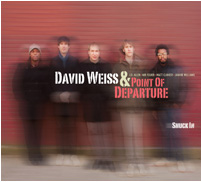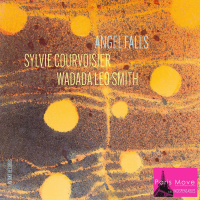Home » Jazz Articles » Record Label Profile » Dreyfus Records: Crossing Continents with Music
Dreyfus Records: Crossing Continents with Music

From an early age, music became an important part of Dreyfus' life. He was only eight years old when his brother initiated him into jazz, an art form which he would later call "the most important music of the century." He would start jazz clubs as a teenager, but he also found his way into publishing and it was the money he made from the discovery of electronic music pioneer Jean Michael Jarre that allowed him to set up his own jazz label, Dreyfus Jazz, in 1991, signing tenor saxophonist Steve Grossman, pianist Michel Petrucciani, accordion player Richard Galliano and gypsy guitarist Bireli Lagrene. Through the years, Dreyfus would maintain his love for those four basic instruments—saxophone, piano, accordion and guitar—and adding a wealth of significant artists to his roster, including saxophonist Rosario Giuliani, pianists Franck Avitabile and Jean-Michel Pilc, accordionist Marcel Loeffler and guitarists Philip Catherine and Luc Sylvain. Drummers also have a special place in the catalog: Aldo Romano, Ari Hoenig and Roy Haynes have all recorded for the label.
When it comes to singers, Dreyfus Jazz is influenced by Dreyfus' preference for singers who have the ability to sound like an instrument, meaning they sculpt vocal lines like a trumpeter or saxophonist would. Some of the most prominent singers on the label—Sara Lazarus, Anne Ducros and Terez Montcalm—have a strong resemblance to the most iconic names in jazz singing, Louis Armstrong, Billie Holiday, Ella Fitzgerald and Sarah Vaughan. The strong tie to jazz tradition is not a coincidence. In fact, part of Dreyfus' life's work was the creation of the Jazz Reference Series, an impressive collection of 70 albums, covering the greatest names in jazz, from Armstrong to saxophonist Art Pepper.
Speaking of the collection, Dreyfus said: "For whom, then, have I imagined doing this 70 volume anthology? For all those who already love jazz, and for those who will find great pleasure in re-discovering it, thanks to sound quality that is unexpected and unequaled. But also for those, namely the younger generation, who don't yet realize that they are going to love this music that burnt down, from its creative violence and its jubilant swing, the entire twentieth century.First, I had to do the near impossible: break the wall of sound in order to enhance the already sublime tracks of yesteryear...to make them sound as though they'd been recorded yesterday. Thanks to technological information storage and resolute research by an exceptional sound engineer, René Ameline, it was possible, with never ending passion and patience, including the best sources (the best songs and the best documents, no second takes and no false starts), to give a new youth to the voice of Ella and Billie, to offer an unheard of freshness to formidable improvisations by Louis Armstrong and Coleman Hawkins."
It is characteristic of Dreyfus, that while certainly interested in the historical importance of jazz music, he first and foremost cared about the freshness and importance of the art of Billie Holiday and saxophonist Charlie Parker. Restoring the music to utmost perfection, he wasn't so much acting as a custodian of old times, but rather as a messenger, making the transition from past to present. This is was what Dreyfus did and his label still does. It makes the musical connection between past and present, European and American traditions. It might seem like a paradox that a French label owner was interested in preserving the musical heritage of America, spreading its grandeur to a young European audience, but in the case of Dreyfus there wasn't a contradiction between being a European and a preserver of jazz tradition.
Dreyfus didn't try to blur the difference between American and European musical traditions. On the contrary, besides caring about the heritage of jazz, he also had a keen understanding of European folklore, signing artists with ties to French folklore and gypsy music, including names such as accordionist Galliano and violinist Didier Lockwood. What Dreyfus saw, however, and this vision permeates through the whole catalog, is that while Europe and America may have separate musical traditions, it is possible to cross continents with music. Jazz could basically be seen as a kind of cultural exchange and nowhere is this idea realized more beautifully than in the releases on the Dreyfus label where music is the only true language that is spoken.
 Steve Grossman
Steve GrossmanSteve Grossman Quartet with Michel Petrucciani
Dreyfus Records
1999
Saxophonist Steve Grossman and pianist Michel Petrucciani both recorded for the Dreyfus label at the very beginning of its history and on Steve Grossman Quartet with Michel Petrucciani, the two giants met up for what can only be termed a magical session. The album became the last recording on which Petrucciani participated, and he is found in sublime form, caressing the tangents with romantic sensitivity. The program is mostly made up of ballads, with such evergreens as "Body and Soul," "Ebb Tide" and "In a Sentimental Mood" receiving stellar readings. Grossman, known for his pyrotechnics and funkiness, digs deep into the material, managing to sound vulnerable and touching without being sentimental. A case in point is "Song for My Mother," an original written by the saxophonist, which cuts to the heart of the matter, using a smoky tone and no fancy embellishments. Petrucciani also contributes to the material with his "Parisian Welcome," an elegant, bluesy ballad. The tempo is picked up on "You Go to My Head" and Sonny Rollins' "Why Don't I?" Both tunes are swinging with a relaxed feeling, but they are only there to highlight what this session is really about: the exploration of pure emotion in slow tempo. The album is a worthy testament to Petrucciani and a proof that Grossman is as good a ballad player as there is.
 Martial Solal
Martial SolalIn & Out
Dreyfus Records
2000
Another strong encounter between two masters of their instruments, incidentally also a French pianist and an American saxophonist, is the duo meeting between Martial Solal and Johnny Griffin on In & Out. While essentially a ballad session in its nature, the album is nevertheless decidedly more modernistic than the musings of Petrucciani and Grossman. Unlike the preponderance of standards found on Steve Grossman Quartet with Michel Petrucciani, In & Out sticks mostly to the original creations of the musicians involved. Solal contributes the title track, "L'Oreille Est Hardie" and "Neutralisme," compositions that all feature the pianist's rollicking licks, hard rhythms and unusual harmonies, coupled with a strange, detached sense of pianistic sensitivity. Griffin, on the other hand, is straighter in his writing, showcasing a swinging touch for balladry on "Come with Me," "Hey Now" and "When You're In My Arms."
Both Griffin and Solal can be seen as modernistic iconoclasts; Griffin with the sound and fury of his fast-paced horn, and Solal with his knotty sense of harmony and rhythm. Nevertheless, they are thoroughly steeped in the standards tradition and the balance between melodic tradition and experimental modernism is perfectly spelled out in the tracks that open and close the session: Nacio Herb Brown's "You've Stepped Out of a Dream" and Thelonious Monk's modern classic "Well, You Needn't." Somewhere between the Great Songbook and the avant-garde lyricism of Monk lies the singular music of this inspired duo.
 Jean-Michel Pilc
Jean-Michel PilcTrue Story
Dreyfus Records
2010
In many ways, pianist Jean-Michel Pilc's playing can be seen as the perfect synthesis between the romanticism of Michel Petrucciani and the modernism of Martial Solal. True Story, published in 2010, finds him in an adventurous trio setting with bassist Boris Koslov and drummer Billy Hart. While "High Sky—The Elegant Universe," "Kingston NY" and "B.B.B.," with their forceful block chords, almost violent outbursts and challenging harmonies, all lie close to the school of Monk and Solal, there is also a fragile lyricism at work which contradicts and supplements the high-pressured energy. Pilc is able, within the same song, to play like a hammer and a feather. Besides a clear nod to jazz tradition in the shape of a playful version of Cole Porter's "My Heart Belongs to Daddy," a notable influence from classical music, especially the romantic music of Franz Schubert, is apparent. Thus, "Relic" is a beautiful jazzy reworking of a composition by the legendary German. Unlike Franck Avitabile, another classically influenced jazz-pianist on the Dreyfus label, whose tonal language lies close to impressionism, Pilc's compositions are perfectly suited to the dramatic ebb and flow of romanticism. He never loses himself in abstract doodling, but, in spite of his experimentalism, always has a story to tell.
 Aldo Romano
Aldo RomanoOrigine
Dreyfus Records
2010
The strain of modernism which can be followed on Dreyfus does not only include pianists like Martial Solal and Jean-Michel Pilc, but also drummer Aldo Romano, saxophonist Rosario Giuliani and guitarist Philip Catherine. Romano is one of a prominent line of drummers who have recorded for Dreyfus, the most famous being Roy Haynes, who has received a special treatment in the shape of a luxurious box set: A Life in Time: The Roy Haynes Story (Dreyfus, 2007). As a stylist, Romano lies closer to the fluorescent timekeeping of Paul Motian than the hard swinging of Haynes, and, like Motian, he is an accomplished and ambitious composer, which is shown on Origine (Dreyfus, 2010), an album that incorporates a wide range of sounds. "Pasolini," a homage to filmmaker Pier Paolo Pasolini, is a silky piece of swing woven in a rich carpet of brass, whereas "Il Camino Part 1-3" are gentle folkloric vignettes, using flutes and Spanish guitar. Throughout the album, Romano shows himself as an exceptional composer of ballads. "Touch of a Woman," "Dreams and Waters" and "For Michel," remembering the late pianist Petrucciani, are all delicate in their complex romantic texture, reminiscent of the vintage songs of Duke Ellington. Origine is a truly significant work from one of the foremost drummers in European jazz.
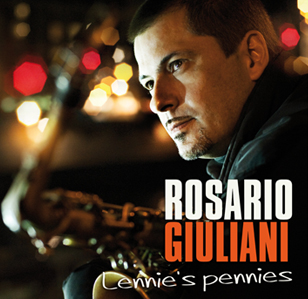 Rosario Giuliani
Rosario GiulianiLennie's Pennies
Dreyfus Records
2010
Whereas Aldo Romano lets his Italian roots shine through in his romantic balladry, saxophonist Rosario Giuliani shows his origin in the wildness and passion of his playing. The famous Italian temperament is translated into a kind of blowing that is both heated and tender. Considering his highly emotional approach to playing, it is ironic that the title track, and the opener on his album Lennie's Pennies (Dreyfus, 2010), is written by the pianist Lennie Tristano, who famously shunned emotionalism in music. However, Giuliani tackles Tristano's contrapuntal intellectualism with grace, making it fresh and fiery.
Overall, Lennie's Pennies sports an eclectic program, with a nice mixture of standards, modern classics such as Jimmy Rowles' "The Peacock" and Joe Zawinul's "74 Miles Aways" and originals by the leader and pianist Pierre de Bethmann, who contributes his lovely "Un Des Sans" and "Patience." The latter is a specially touching ballad, adorned by crystalline harmonies on Fender Rhodes. Giuliani shines strongly on his own swinging, mid-tempo ballad, "Dear Father," and also showcases a knack for Charlie Parker-like bop on the fast-paced "Over Lines." Lennie's Pennies certainly isn't cool jazz or third stream, but it is a nice selection of tunes from a very hot saxophonist.
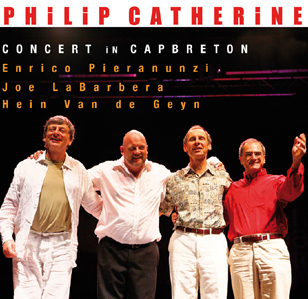 Philip Catherine
Philip CatherineConcert in Capbreton
Dreyfus Records
2010
Belgian guitarist Philip Catherine is a melodic modernist who received his breakthrough by playing with trumpeter Chet Baker on the album Live in Bologna 1985 (Dreyfus, 1985), a classic in the Dreyfus catalog. Concert in Capbreton (Dreyfus, 2010) is a fine example of Catherine's ability as a superior colorist. In the company of bassist Hein Van de Geyn, drummer Joe La Barbera and pianist Enrico Pieranunzi, Catherine explores a program of old and modern standards, with the ballad "Change," written by Van de Geyn, thrown in for good measure. The concert starts with the Chet Baker signature song, "My Funny Valentine." Here, Catherine creates an impressionistic mood piece, stretching lines bathed in reverb, while Pieranunzi makes a shimmering carpet of bell-like tonalities resound in the background. "My Foolish Heart," another signature piece played by LaBarbera's former employer, pianist Bill Evans, is played with lightly swinging lyricism, and the rest of the concert also sticks to a program of ballads, with Kurt Weill's "Speak Low" ending the set. Concert in Capbreton shows Catherine as a reflective guitarist who gives plenty of room to his fellow players while, at the same time, managing to bring the warm sound of his instrument into focus. The combination of piano and guitar isn't always a successful one, with the guitarist often disappearing between the chords of the piano, but Catherine and Pieranunzi is a perfect partnership. Both are lyrical musicians who are interested in sound and space and together they create an environment where advanced group communication is the highest priority.
 Sara Lazurus with Biréli Lagrène's Gypsy Project
Sara Lazurus with Biréli Lagrène's Gypsy ProjectIt's All Right With Me
Dreyfus Records
2007
Compared to Philip Catherine, Biréli Lagrène is a very different guitarist. In terms of style, Lagrène plays a stunning kind of gypsy guitar in the tradition of the legendary Django Reinhardt. On the album It's All Right With Me, he teams up with elegant singer Sara Lazarus, winner of the Thelonious Monk Institute Jazz Vocal Competition, and it's a match made in heaven. Lagrène's rollicking, folkloric licks suit the singer's sophistication perfectly, giving tunes such as "Taking a Chance on Love" and "Down with Love" a vibrating freshness. The latter is particularly impressive, with the guitarist's lightning fast runs matched by the potent phrasing of Lazarus. Together they engage in a musical dialogue where the songs twist and turn in a joyful celebration of life. However, there is also time for more subdued moments, as when a string section accompanies the singer on a softly sighing version of "In the Wee Small Hours of the Morning." The Dreyfus catalog boasts some very strong singers, including Anne Ducrus and Terez Montcalm, but no one is more versatile than Lazurus, who is an eminent swinger, a sensitive balladeer and an accomplished stylist interested in a broad range of musical traditions.
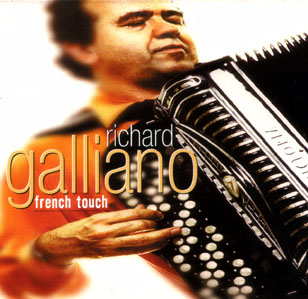 Richard Galliano
Richard GallianoFrench Touch
Dreyfus Records
1999
A special musical tradition lies at the heart of the artistry of accordion player Richard Galliano. He is steeped in the genre of musette, a kind of French ballroom music that emerged in early 20th century France. However, Galliano is also something of a romantic eclectic who isn't afraid to bring flavors from around the world into his jazzy folk-music. This is clearly heard on the opening track on the album that is considered one of his masterpieces: French Touch (Dreyfus, 1999). Here, Galliano kicks off with a warmly swinging version of Brazilian master Hermeto Pascoal's composition "Bébé."
Elsewhere, he delivers a virtuosic version of Michel Legrand's "You Must Believe in Spring," changing convincingly between tempi. Helping him out are two solid rhythm sections, with Jean-Francois Jenny-Clark and Rémi Vignolo sharing the bass duty and Daniel Humair and André Ceccarelli taking care of the drums. emphasiz lies on the waltz, but Galliano never grows stale in the treatment of his instrument. He makes it laugh, sing and cry like a human voice. He never loses sight of the empathic display of feelings that connects his art with a romantic aesthetic, conveying the image of amorous lovers sitting in abandoned cafés on a starlit night. There's a chamber-like intimacy about Gallliano's music that serves it well. It is modern French folk-music of the highest order.
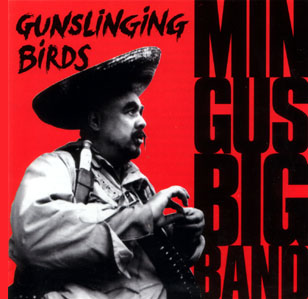 Mingus Big Band
Mingus Big BandGunslinging Birds
Dreyfus Records
1995
While there's a long way from the chamber-like waltzes of Richard Galliano to the full-blown heat of the Mingus Big Band, what they share is a sense of swing and intimacy. Since its beginning, the Mingus Big Band has revitalized the music of bassist and composer Charles Mingus, making the music burn with a wide spectrum of instrumental colors. Over the years, the big band has included such names as pianists Kenny Drew, Jr. and David Kikoski and saxophonists like Chris Potter and Seamus Blake. However, while the orchestra certainly features a host of strong individual voices, what really matters is the organic unity of the band. Gunslinging Birds (Dreyfus, 1995) is the second album from the big band and catches it in one of its earliest and most forceful incarnations. The program includes such classics as "Reincarnation of Love Bird" and "Fables of Fabus," but also gives room for more undervalued material like the madly swinging homage to bassist Oscar Pettiford, "O.P.," and the gut-wrenching "Hog Callin' Blues." With a sound that is both contemporary and faithful towards Mingus' musical intentions, the Mingus Big Band is a beautiful example of Francis Dreyfus' intention of making jazz history relevant to the modern listener. It is music that combines the threads of the past and the present in a bodily cry for freedom and peace.
 Ahmed Jamal
Ahmed JamalA Quiet Time
Dreyfus Records
2010
Another example of a forward-thinking traditionalist is the pianist Ahmad Jamal, perhaps the most famous name on the label. While Jamal's prominence is mostly due to the recordings he did in the late 1950s and 1960s, especially the groundbreaking recordings from The Pershing and The Spotlite Club, he still continues to enhance the vocabulary of his art. A nice addition to the conventional form of the trio has been the addition of percussionist Manolo Badrena who played on It's Magic and also finds his way into Jamal's release from 2010, A Quiet Time. While the title points to the contemplative mood of the album, it also a little deceiving, because it's certainly not a slow ballad-album. Instead, Jamal navigates between gentle lyricism and brisk waves of rhythm and melodic embellishments. Badrena gives a nice exotic touch to tunes like title track and "My Inspiration," adding a productive dynamic for Jamal to play against. All the while, Jamal's longtime collaborator bassist James Cammack and new drummer Kenny Washington - Vocals add a supple rhythmic accompaniment to the luxurious phrasings of the pianist, always in tune to the unexpected moves from the keys.
A Quiet Time is a another strong album from Jamal who has released some of his most significant works on Dreyfus Jazz. Though Francis Dreyfus has passed away, the spirit of his musical generosity still lingers on in the releases that come from label. They are about curiosity, quality and trans-cultural collaborations, a beautiful proof that music is able to bridge the gap between past and present, self and other. It's an idealistic enterprise, perhaps, but, nevertheless, a viable goal for one of the great jazz labels in the business.
Tracks and Personnel
Steve Grossman Quartet with Michel Petrucciani
Tracks: Ebb Tide; Inner Circle; Song For My Mother; Parisian Welcome; You Go To My Head; Body & Soul; Why Don't I?; Don't Blame Me; Theme For Ernie; In A Sentimental Mood.
Personnel: Steve Grossman: saxophone; Michel Petrucciani: piano; Andy McKee: bass; Joe Farnsworth: drums.
In & Out
Tracks: You Stepped Out Of A Dream; Come With Me; In & Out; Hey Now; L'Oreille Est Hardie; When You're In My Arms; Neutralisme; Well, You Needn't.
Personnel: Johnny Grifin: tenor saxophone; Martial Solal: piano.
True Story
Tracks: The Other Night; Relic; PBH Factor; A Brief History Of Time; High Sky, The Elegant Universe; Mornings With Franz; Kingston, NY; Try To Remember; B.B.B.; My Heart Belongs To Daddy; True Story Scene 1; True Story Scene 2; True Story, Scene 3; True Story, Scene 4; True Story, Scene 5.
Personnel: Jean-Michel Pilc: piano; Boris Kozlov: bass; Billy Hart: drums.
Origine
Tracks: Silenzio; Pasolini; Il Camino Part I; Il Camino Part II; Gamelan; Touch of a Woman; Elis; Celestina; Dreams and Waters; Starless Night; For Michel; Il Camino Part III; Jazz Messengers.
Personnel: Aldo Romano: drums, guitar, vocals; Lionel Belmondo: soprano & tenor saxophone, flute; Eric Legnini : piano; Thomas Bramerie: bass; Stéphane Belmondo: trumpet; Philippe Gautier: flute; Jérôme Voisin: clarinet, bass clarinet; Bernard Burgun: vocals; François Christin: vocals; Cécile Hardouin: bassoon; Bastien Stil: tuba; Géraldine Laurent : alto saxophone; Xavier Desandre-Navarre: percussion.
Lennie's Pennies
Tracks: Lennie's Pennies; Love Letters; How Deep is the Ocean; 74 Miles Aways; Picchi; Over Lines; Dear Father; The Peacocks; Un Des Sans; Goldfish; Patience.
Personnel: Rosario Giuliani: alto saxophone; Pierre de Bethmann: piano, fender Rhodes; Darryl Hall: bass; Joe La Barbera: drums.
Concert in Capbreton
Tracks: Announcement (introduction of the band); My Funny Valentine; My Foolish Heart; Broken Wings; Beatrice; Change; You've Changed; Speak Low.
Personnel: Philip Catherine: guitar; Enrico Pieranunzi: piano; Joe LaBarbera: drums; Hein Van de Geyn: bass.
It's All Right With Me
Tracks: Gypsy in My Soul; Taking a Chance On Love; What a Little Moonlight Can Do; Embraceable You; It's All Right With Me; Dans Mon Ile; Deed I Do; Down With Love; Jim; The Way You Look Tonight; In the Wee Small Hours of the Morning; Cheek to Cheek.
Personnel: Sara Lazarus: vocals; Biréli Lagrène: guitar; Hono Winterstein: guitar; Diego Imbert: double bass; Andre Ceccarelli: drums; Raymond Gimenes: arrangements.
French Touch
Tracks: Bébé; French Touch; J.F.; Caruso; Heavy Tango; Sanguine; Augusta; You Must Believe in Spring; Passarinho; Sanfona; L'envers du décor; Tacot Blues.
Personnel: Richard Galliano: accordion; Jean-François Jenny-Clark: bass (2-4, 6, 7, 11, 12); Rémi Vignolo: bass (1, 5, 8, 10); Daniel Humair: drums (2-4, 7, 9, 11, 12); André Ceccarelli: drums (1, 5, 8, 10); Michel Portal: soprano saxophone (3); Jean-Marie Ecay: acoustic guitar (1, 10).
Gunslinging Birds
Tracks: Gunslinging Birds; Reincarnation of a Love Bird; O.P.; (Oscar Pettiford); Please Don't Come Back from the Moon (Pinky); Fables of Fabus; Jump Monk; Noon/Night/Celia (medley); Hog Callin' Blues; Started Melody.
Personnel: Randy Brecker, Philip Harper, Ryan Kisor : trompet; Jamal Haynes, Earl McIntyre, Franck Lacy: trombone; Gary Smulyan : baritone saxophone; Craig Andy, John Stubblefield, Chris Potter: tenor saxophone; David Lee Jones: alto saxophone; Kenny Drew Jr. : piano; Andy Mc Kee: bass; Adam Cruz: drums.
A Quiet Time
Tracks: Paris After Dark; The Love Is Lost; Flight to Russia; Poetry; Hi Fly; My Inspiration; After JALC (Jazz at Lincoln Center); A Quiet Time; Tranquility; The Blooming Flower; I Hear a Rhapsody.
Personnel: Ahmad Jamal: piano; James Cammack: bass; Manolo Badrena: percussion; Kenny Washington: drums.
Tags
Dreyfus Records
Record Label Profiles
Jakob Baekgaard
United States
Ahmad Jamal
orrin keepnews
Lester Koenig
Michel Petrucciani
Richard Galliano
Bireli Lagrene
Jean-Michel Pilc
Philip Catherine
Aldo Romano
ari hoenig
Roy Haynes
Sara Lazarus
Louis Armstrong
Billie Holiday
Ella Fitzgerald
Sarah Vaughan
Art Pepper
Charlie Parker
Didier Lockwood
Steve Grossman
Sonny Rollins
Martial Solal
Johnny Griffin
Thelonious Monk
Paul Motian
duke ellington
Lennie Tristano
Jimmy Rowles
Joe Zawinul
Pierre de Bethmann
Chet Baker
Joe Labarbera
Enrico Pieranunzi
Bill Evans
Django Reinhardt
Hermeto Pascoal
Jean-Francois Jenny-Clark
Daniel Humair
Andre Ceccarelli
Mingus Big Band
Charles Mingus
Kenny Drew, Jr.
David Kikoski
Chris Potter
Seamus Blake
Oscar Pettiford
Kenny Washington
PREVIOUS / NEXT
Support All About Jazz
 All About Jazz has been a pillar of jazz since 1995, championing it as an art form and, more importantly, supporting the musicians who make it. Our enduring commitment has made "AAJ" one of the most culturally important websites of its kind, read by hundreds of thousands of fans, musicians and industry figures every month.
All About Jazz has been a pillar of jazz since 1995, championing it as an art form and, more importantly, supporting the musicians who make it. Our enduring commitment has made "AAJ" one of the most culturally important websites of its kind, read by hundreds of thousands of fans, musicians and industry figures every month.



